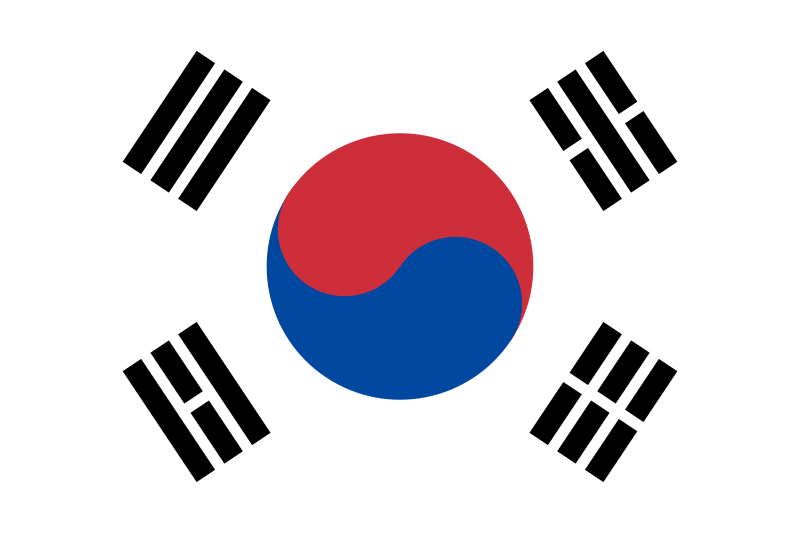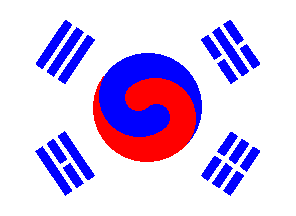The Korean flag
The Korean flag is full of meaning. Though, depending on who you consult, it can mean many different things.
Elements of the Taegukgi [태극기]:
- Taeguk (the red and blue yin-yang symbol in the center): represents the cosmic forces of yin (blue) and yang (red) that gave birth to everything in the universe. Blue implies hope, while red is supposed to signify nobility. They combine to represent the creation of the truth (truthiness?) of the universe.
- White background: represents one, or all, of the following things: purity; the brightness of the Baeguiminjok [배귀민족] - people wearing white; and the desire of the Korean people for peace. Who knew white meant so many things? It's harder to keep straight than Ricky Martin.
- Gwae [괘] - in the four corners: represents movement and harmony. They also function conveniently as those optical illusions where you stare at them for 30 seconds and watch the dots appear.

Gon [곤]: earth, summer, west, righteousness, mother, and/or fertility.
Gam [감]: moon, winter, north, intelligence, daughter, water, and/or vitality.
Ri [리]: sun, autumn, south, courtesy, sun, fire, and/or wisdom.
It's sort of like a choose-your-own-adventure, all wrapped up into one convenient national icon!
* An interesting note, in answer to the question posed by Kevin: it appears that Korea chose to represent only four of the eight ba gua (also called gwae [괘], yi-ching, or tri-grams), all of which can be seen below in earlier versions of the flag, as a matter of simplicity and convenience.
It's interesting that they chose the simplified version, given the fact that the eight kwae matched the number of provinces (not including metropolitan cities and the special self-governing province, i.e. Korea's Hawaii).In April 1882, an official Korean-Chinese meeting was held to discuss the question of the Korean flag. The "teaguk" emblem was proposed for the first time during this meeting. Official documents of the Korean Royal court state that the Chinese delegate Ma Chien-Chung promoted the use of the Yin-Yang spiral in red and blue and eight combinations of the Yi-ching, and imposed his views to the Korean delegate Kim Hong-Jip. Ma Chien-chung explained the symbolism of his proposal. The eight Yi-ching diagrams matched the eight Korean provinces, and red was the colour of the King whereas blue was the colour of ordinary people. Korea eventually adopted its flag under Chinese pressure and used it for its first diplomatic mission as said above.The first version of the "taeguk" was very close to the original Yi-Ching diagram, which includes eight subdiagrams. The deletion of four of these subdiagrams is reported in the diary of Prince Pak Yeong-Hyo. The Prince showed the original flag design to James, the British captain of the vessel used for the mission. James found the design too complicated and proposed to delete four of the eight Yi-Ching diagrams.
These are some earlier images of the Korean emblem, as used in official delegations:
date unknown
circa 1893
circa 1893







I wonder why they only used half of the bagua? I mean, I guess out of the 8, those four are probably more cardinal or essential or primary or whatever. The I Ching sometimes breaks it down to just heaven and earth as the basic two. Hmm. Maybe it's better for representing a nuclear family? I wonder if there's a historical reason?
ReplyDeleteupdate posted
ReplyDeleteI'm a Korean.
ReplyDeleteand I think that you love Korea.
So, I should like to say a word.
Korean flag hangeul name is 태극기.
not 태국기.
Perhaps you are confused 국기, 태극기.
국기 means national flag.
태극기 means Korean flag.
Your romanization is O.K. but please correct hangeul.
Ahh, thanks for the correction. Perhaps I was confused by the romanization, which is misleading. Technically it should be romanized as Taegeukgi then.
ReplyDelete